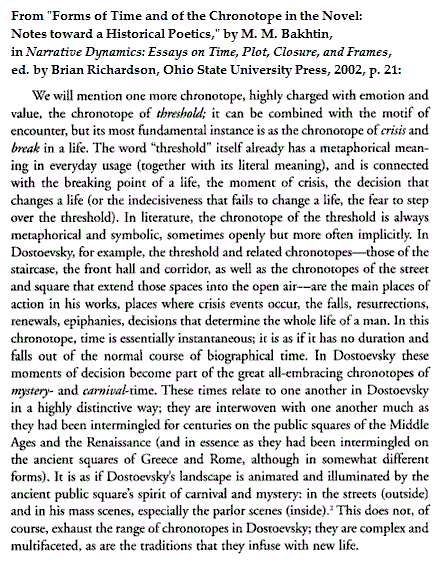* See as well "Public Square" in other posts.
Monday, October 23, 2017
Saturday, September 18, 2010
The Public Square
There are "worrying signs of a failure to appreciate…
the legitimate role of religion in the public square."
— Pope Benedict XVI in Westminster Hall on Friday
Related material on the public square —
Friday, September 7, 2018
Carnival and Mystery
Monday, July 16, 2018
Greatly Exaggerated Report
"The novel has a parallel narrative that eventually
converges with the main story."
— Wikipedia on a book by Foer's novelist brother
Public Squares
An image from the online New York Times
on the date, July 6,
of the above Atlantic article —
An image from "Blackboard Jungle," 1955 —
"Through the unknown, remembered gate . . . ."
Tuesday, April 5, 2016
Stevens Illustrated
A Hard Card
From the April 2 obituary of a counterculture figure —
"Ms. Crystal was born Jacqueline Diamond
on Dec. 21, 1947, in Manhattan and grew up
in Mamaroneck, N.Y. Her father, Jack, owned
J. Diamond Furs. Her mother, the former Rita
Dunn, was a fur model who, after marrying,
stayed home to raise her children."
— William Grimes in The New York Times
"Jack o' Diamonds is a hard card to play."
From Log24 on the reported date of Ms. Crystal's death —
Tuesday, March 1, 2016
Edifice
"Euclid's edifice loomed in my consciousness as a marvel among
sciences, unique in its clarity and unquestionable validity."
—Richard J. Trudeau in The Non-Euclidean Revolution (1986)
See also Edifice in this journal and last night's architectural post.
Saturday, May 18, 2013
Midnight in Bakhtin
A followup to last midnight's Black Hole Revisited .
See also Victor Turner on liminality, together with Paul Goodman
on public squares, in a post of May 8, 2007.
Related material: Midnight in Dostoevsky (St. Andrew's Day, 2009).
Thursday, March 19, 2009
Thursday March 19, 2009

[Note: Janus is Roman, not Greek, and
the photo is from one “Fubar Obfusco”]

Click on image for details. From January 8:
Religion and Narrative, continued:
|
Context:
Notes on Mathematics and Narrative
(entries in chronological order,
March 13 through 19)
Thursday, January 8, 2009
Thursday January 8, 2009
A Public Square
In memory of
Richard John Neuhaus,
who died today at 72:
“It seems, as one becomes older,
That the past has another pattern,
and ceases to be a mere sequence….”
— T. S. Eliot, Four Quartets

See also The Folding.
Tuesday, May 8, 2007
Tuesday May 8, 2007
Symbology:
“Also known as ‘processual symbolic analysis,’ this concept was developed by Victor Turner in the mid-1970s to refer to the use of symbols within cultural contexts, in particular ritual. In anthropology, symbology originated as part of Victor Turner’s concept of ‘comparative symbology.’ Turner (1920-1983) was professor of Anthropology at Cornell University, the University of Chicago, and finally he was Professor of Anthropology and Religion at the University of Virginia.” —Wikipedia
Symbology and Communitas:
|
From Beth Barrie’s
“Victor Turner“— “‘The positional meaning of a symbol derives from its relationship to other symbols in a totality, a Gestalt, whose elements acquire their significance from the system as a whole’ (Turner, 1967:51). Turner considered himself a comparative symbologist, which suggests he valued his contributions to the study of ritual symbols. It is in the closely related study of ritual processes that he had the most impact.
The most important contribution Turner made to the field of anthropology is his work on liminality and communitas. Believing the liminal stage to be of ‘crucial importance’ in the ritual process, Turner explored the idea of liminality more seriously than other anthropologists of his day. As noted earlier Turner elaborated on van Gennep’s concept of liminality in rites of passage. Liminality is a state of being in between phases. In a rite of passage the individual in the liminal phase is neither a member of the group she previously belonged to nor is she a member of the group she will belong to upon the completion of the rite. The most obvious example is the teenager who is neither an adult nor a child. ‘Liminal entities are neither here nor there; they are betwixt and between the positions assigned and arrayed by law, custom, convention, and ceremonial’ (Turner, 1969:95). Turner extended the liminal concept to modern societies in his study of liminoid phenomena in western society. He pointed out the similarities between the ‘leisure genres of art and entertainment in complex industrial societies and the rituals and myths of archaic, tribal and early agrarian cultures’ (1977:43). Closely associated to liminality is communitas which describes a society during a liminal period that is ‘unstructured or rudimentarily structured [with] a relatively undifferentiated comitatus, community, or even communion of equal individuals who submit together to the general authority of the ritual elders’ (Turner, 1969:96). The notion of communitas is enhanced by Turner’s concept of anti-structure. In the following passage Turner clarifies the ideas of liminal, communitas and anti-structure:
It is the potential of an anti-structured liminal person or liminal society (i.e., communitas) that makes Turner’s ideas so engaging. People or societies in a liminal phase are a ‘kind of institutional capsule or pocket which contains the germ of future social developments, of societal change’ (Turner, 1982:45). Turner’s ideas on liminality and communitas have provided scholars with language to describe the state in which societal change takes place.”
Turner, V. (1967). The forest of symbols: Aspects of Ndembu ritual. Ithaca, NY: Cornell University Press. Turner, V. (1969). The ritual process: structure and anti-structure. Chicago: Aldine Publishing Co. Turner, V. (1977). Variations of the theme of liminality. In Secular ritual. Ed. S. Moore & B. Myerhoff. Assen: Van Gorcum, 36-52. Turner, V. (1982). From ritual to theater: The human seriousness of play. New York: PAJ Publications. |
Related material on Turner in Log24:
Aug. 27, 2006 and Aug. 30, 2006. For further context, see archive of Aug. 19-31, 2006.
Related material on Cuernavaca:
Google search on Cuernavaca + Log24.








